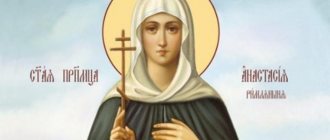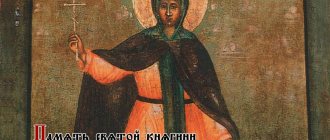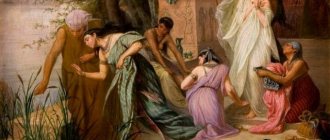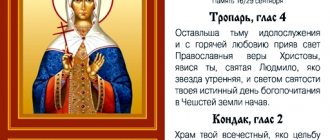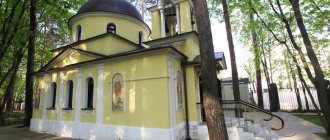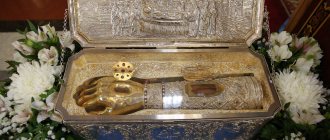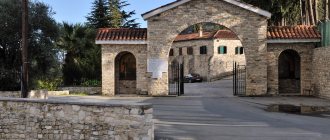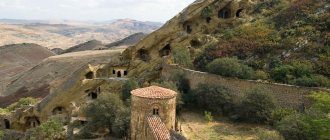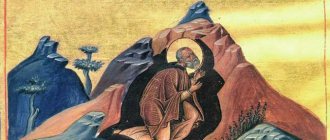"Save me, God!".
Thank you for visiting our website, before you start studying the information, please subscribe to our Orthodox community on Instagram, Lord, Save and Preserve † - https://www.instagram.com/spasi.gospodi/. The community has more than 60,000 subscribers. There are many of us like-minded people and we are growing quickly, we post prayers, sayings of saints, prayer requests, and timely post useful information about holidays and Orthodox events... Subscribe. Guardian Angel to you!
Among the wide variety of saints, it is worth highlighting those who zealously followed the foundations of Orthodoxy. One such example is the life of St. Nikita of Novgorod. With his fervent prayers he was able to avoid being seduced by demons. With such actions, he shows that faith in God and sincerity in reading sacred texts will help him cope with any troubles.
Life of the Holy Recluse
Little is known about childhood. Mentions begin from the moment when his monastic path began in the 11th century in the Kiev Pechersk Lavra. Youthful maximalism played a cruel joke on him. He decided to retire to a cave, although the abbot was against it. This happened due to his lack of identification in this case. Those elders who understood his offense prayed for him.
After some time, his place was filled with fragrance. The Lord himself turned to him that he sent his angel to help him and Nikita must do everything that is necessary. But it was a test. A demon appeared to him and ordered him to stop praying and read the Old Testament all the time. After a certain hour he was given the gift of foresight.
Crowds of people came to him to find out about their future. But then it was noticed that he never talks about the New Testament. The elders decided to bring him out of the demonic delusion. The monks came to him and drove him out with the prayers of the false angel. The saint admitted his error and left his place of residence.
The best article for you, go to: What does the icon of Saint Prince Alexander Nevsky help with?
As soon as the obsession passed, it seemed to many that he had fallen into childhood. He learned to read again and shed bitter tears because of his mistake. This forced him to continue to live in obedience and complete humility. Daily hard work and study of holy texts led to the achievement of the rank of bishop. Even after his death, he never ceased to amaze with his miracles.
Where are the relics of St. Nikita of Novgorod? Initially he was buried in St. Sophia Cathedral. Later, the remains were transferred to the Church of St. Phillip the Apostle, which is located in the northern aisle.
How do you approach a saint?
Just like other saints, people come to him with their needs. Many people say that it is important to concentrate and thoughtfully pronounce everything that is gnawing at you. What is St. Nikita of Novgorod asked for in Orthodoxy? He is considered to be an assistant in this matter:
- healing of eye diseases;
- eliminating health problems;
- strengthening faith;
- resisting temptations;
- separating truth from lies;
- finding the right path;
- achieving the intended goals.
BARBARS AND PILGRIMS
Attracted by the legend about the hidden treasure, barbarians flocked to the shrine: some picked the floor and drilled the walls in search of treasure, others removed the valuable snow-white stone, others simply destroyed and mocked, reveling in their impunity.
The tormentors of Nikita Gothsky were unable to destroy his spiritual fire with physical fire. Hundreds of believers flocked to the burial place of the great martyr. People found holy consolation, hope and healing near the relics. Subsequently, the relics were transferred to Constantinople. Soldiers still offer prayers to this saint, mothers turn to him with prayers, they ask him for consolation in sorrows and protection from persecution.
A spiritual fire also burns in the destroyed church in the village of Teploye. As if to the relics of St. Nikita, pilgrims go to the Church of the Sign - to touch, cry and pray. Thanks to the “Road to the Temple” program of the Moscow Region Governor Andrei Vorobyov, a comfortable path to the Znamenskaya Church has appeared. In 2008, with the blessing of the head of the Moscow diocese, Metropolitan Juvenaly of Krutitsy and Kolomna, the Church of the Sign was assigned to the parish of the Transfiguration Church in the village of Nudol in the Klin urban district. Divine services began here.
“The real life, like that of the martyrs, began at the temple with the beginning of persecution,” says Father Arkady. “It’s a very difficult, bitter, hard-won story that you have to look at like in a mirror.” It is extremely expensive and very difficult to restore the martyr temple. But first, we can at least stop its destruction. We need to keep ourselves and others from barbarism. And it is very important to come and pray - as for a person...
Holy face
Turning to the icon of St. Nikita of Novgorod also helps in finding a decent job, as well as obtaining an excellent education. Placing it in the house will help protect it from thieves, fire, and natural disasters. And for residents it will protect against deception and misconception. There is an opinion that reading a prayer from this image will have greater power. Here is her text.
Oh, the bishop of God, Saint Nikito! Hear us sinners, who today flock to this sacred temple, and worship your honorable image, and fall to your sacred race, and cry out with emotion: as if sitting on the throne of the sanctity in this Great Novegrad, and the only lack of rain, you brought down the rain with prayer, and again I will engulf this city with a fiery flame, you have given me a prayer to deliver, so now we pray to you, O Saint Nikito of Christ: pray to the Lord to deliver the reigning city, this Great Novgrad and all Christian cities and countries from cowardice, flood, famine, fire, hail , sword and from all enemies visible to invisible, for we are saved by so many for the sake of your prayers, we glorify the Most Holy Trinity, the Father and the Son and the Holy Spirit, and your merciful intercession, now and ever, and unto the ages of ages. Amen.
If this also happens on Memorial Day, the effectiveness will increase several times. In Christianity, the feast day of the holy recluse falls on February 13, May 13 and May 27.
Great Martyr Nikita
When the honorable and life-giving cross of the Lord, this sign of victory, was raised high above the world, then Saint Nikita, the same name for victory, came under its shadow. On the eve of this day we celebrated the Exaltation of the Holy Cross, this victory invincible for the world, and now we honor Saint Nikita, whose name means winner [].
This good warrior of Jesus Christ stood under the cross, as if under a banner, to wage war against the enemies of the Holy Cross, in honor of Him Crucified on it. One fights for the king of the earth, another for his life and vain glory, another for temporary riches, but Saint Nikita fought for his only Lord Jesus Christ, Who is the King of every creation and our glory and never-failing wealth. And where and how this warrior labored for Christ - the following is told about this.
When, during the reign of the holy Equal-to-the-Apostles King Constantine the Great, the holy faith began to spread throughout the entire universe, then in the Gothic country [], on the other side of the Istra [] (Danube) River, holy piety shone like a light in the darkness. In that country Saint Nikita was born, baptized and raised. The Gothic Bishop Theophilus [], who took part in the first Council of Nicea, confessed the dogmas of the Orthodox faith and signed the definitions of the council - enlightened Nikita with the light of faith and baptized him in the name of the Father and the Son and the Holy Spirit.
After a little time, the ancient envious devil, unable to bear the fact that the holy faith of Christ was spreading and the number of Christians was increasing more and more, raised in this barbaric land, darkened by idolatry, a struggle and strong persecution against those professing the name of Christ and believing in the Lord. The spirit of evil inspired the prince of that country, named Phanarikh, to kill Christians and destroy even the memory of them from his land.
At that time, division and internecine warfare occurred among the Goths. They were divided into two parts: one part had a certain Fritigern as its leader, and the other was led by the cruel tormentor Athanaric. When these fellow tribesmen came together to fight and great bloodshed occurred, Athanaric, who had more strength and courage, overpowered and defeated his opponent and put his army to flight. The defeated Fritigern fled to Greece, where he sought help from the Christ-hating king Valens []; the emperor ordered the entire army that was in Thrace to go to the aid of Fritigern.
After this, Fritigern, with all his remaining warriors and the Greek army gathered in Thrace, set out against his rival. Crossing the Istr (Danube) River, he ordered an image of the holy cross to be made and carries this image in front of his regiments. So he attacked Athanaric.
A terrible battle took place, but the Christians, with the help of the cross, defeated Athanaric and defeated his entire army: they killed some, captured others, so that he himself and his small retinue barely managed to escape. From that time on, the Christian Orthodox faith began to spread more and more among the Goths, for many, seeing the irresistible power of the cross manifested in the battle, believed in the Lord Crucified on the cross.
When Bishop Theophilus died, Urfil [], a prudent and pious man, took over his see. He invented writing for the Goths and translated many books from Greek into Gothic, so that the holy Christian faith spread among the Goths more and more every day. Saint Nikita, one of the noblest and most glorious persons of that land, also contributed with his zeal to the establishment of faith in Christ there. With his piety and divinely inspired words, he led many to Christ.
After some time, the wicked Athanaric again returned to his homeland. Having achieved power and strength, he, taught by the demon, raised a terrible persecution against Christians in his area, trying to avenge his humiliation, since he was defeated and disgraced by Christians in battle.
Then Saint Nikita, inflamed by zeal for God, went out to fight both enemies, invisible and visible: he fought against the invisible enemy, converting the infidels to the true faith and preparing the believers for martyrdom; he fought against the visible enemy, denouncing the tormentor Athanaric and reproaching him for his godlessness and inhumanity, for the fact that he betrayed many believers to various torments; Thus Saint Nikita defeated both: he trampled on the devil and overcame the severity of the tormentor. The various torments with which they wanted to force the good sufferer of Christ to renounce Christ were powerless, and the tormentor himself was at a loss why, with all his power, he could not bend to his wickedness one servant of Christ, firm in his confession like a strong and unshakable pillar
What was the lawless one up to then? He planned to destroy with fire the one whom he could not kill with many wounds, torture of the flesh and crushing of the members. But what has the wicked achieved? He burned himself more with his rage than the martyr with flame: Saint Nikita, although he was in the fire, his body was not burned by the fire, but his soul was reborn for a new eternal immortal life. Meanwhile, the tormentor burned without fire from his atheism: he deadened his soul and prepared his body for hell. So Saint Nikita fought for Christ under the sign of the cross and showed himself to be a winner; not only in name, but in reality he was one.
The body of the saint, undamaged by the fire, was left without burial and lay there, being thrown out with dishonor. At that time, there lived only a pious Christian named Marian. This husband was from the Cilician country, from the city of Mopsuestia []. On some business he came to the Gothic land, and stayed here for quite a long time. Marian met Saint Nikita and acquired his friendship and love; He especially loved him when he saw that the holy ascetic stood for the holy faith of Christ even to the point of being ready to shed his blood for it.
And so, when the body of the saint lay unburied, Marian thought about how he could take the body of his beloved friend and martyr of Christ and take it to his native country. But he was afraid to carry out his intention, out of fear of the prince, who ordered that no one dare bury the body of the martyr. Then Marian decided to take it secretly at night.
When night fell, Marian was ready to go out on his planned business; but the night was dark and rainy, so it was difficult for him to walk. Marian was greatly saddened by this, for he did not see where to go and where to find the body of the martyr that was being sought. When he greatly grieved over this, the God of all consolations, who once showed the Magi with a star the way to Bethlehem (Matthew 2:2), comforted Marian in his sorrow and showed him a favorable path to finding the saint’s body: He sent some heavenly power in the form of a star, which, shining before Marian, led him where he needed to go. This star preceded Marian and dispersed the darkness of the night; he followed her with joy. Having reached the place where the saint’s body was located, the star stopped above him. Then Marian, wrapping a clean shroud around the body of the martyr, carried him to the house where he lived.
This is how Marian received the treasure he was looking for. Having hidden it for a while in his home with great care, he soon after this returned to his fatherland and brought with him the body of the holy martyr []. Arriving in the city of Mopsuestia, Marian buried him with honor in his house.
God sent down a blessing to the house of Marian for the sake of His passion-bearer, Saint Niketas, as He once blessed the house of Pentephry with many riches for the sake of Joseph (Gen. 39:5) and the house of Abeddar for the sake of the Icon of the Covenant (2 Sam. 6:11). The house of Marian began to abound in great wealth: both material and spiritual, for from the tomb of the saint many gifts were given to all those in need and many healings were sent down to the sick.
The entire city and surrounding residents gathered at the saint’s tomb, so that Marian’s house could not accommodate all the believers who gathered here; Therefore, everyone decided to build a church in the name of Saint Nikita and place the relics of the martyr there. Taking up this task with zeal, the believers soon erected a temple. At the end of the building, when the temple was decorated with appropriate splendor, the tomb of the holy martyr was opened and, taking the ark, they carried it to the newly created church and here they buried it in the ground. Only one Marian managed to take, to bless his house from the relics of the saint, one finger, which he kept with reverence; no one else could take a single particle from the relics of Saint Nikita.
One day, blessed Auxentius, Bishop of Mopsuestia, having created a church in honor of the holy martyrs Tarakh, Provos and Andronikos [], sent a message to the city of Anazarva [], where the relics of these three saints rested; in his message, he asked the citizens of Anazarwa to give some of the relics of the holy martyrs for the newly built temple. Then the citizens of Anazarva asked Auxentius to give them in return some of the relics of Saint Nikita to bless their city. Wanting to fulfill their request, the bishop ordered the tomb of the holy martyr Nikita to be opened.
And so, for no apparent reason, the marble stone that was on the saint’s tomb broke into two halves. One of those present here boldly touched the holy relics with his hand, but immediately his hand dried up, and horror attacked him. At the same time, a strong clap of thunder sounded from the sky and bright lightning flashed; everyone was in fear. Then the bishop realized that God did not bless the crushing of the saint’s relics, and he repented of his intention. Taking the withered hand of the man who had boldly touched the relics of the saint, he again touched the relics with it and began to pray:
- Oh, holy martyr of Christ Nikita! It is more fitting for you to heal than to harm, for you are good and imitate the All-Good Lord, and if you quickly punished this man, then wouldn’t you rather have mercy on him?
As soon as the bishop uttered these words, the withered hand of that man was immediately healed, and everyone was amazed at the miracles of the holy martyr Nikitas and glorified God. Not daring to touch the relics of the saint of God anymore, the bishop [], having performed reverent singing over them, again closed his tomb with honor, glorifying the Father and the Son and the Holy Spirit, the One God in the Trinity, to Whom belongs all glory, honor and worship forever. Amen.
Notes:
[] Nikita - translated from Greek as “winner”.
[The] Gothic country extended from the lower Vistula to the Black Sea; The Goths lived mainly in what is now Romania, along the Danube.
[] Istr is the ancient name of the Danube.
[] Mind. around 340.
[] Emperor Valens reigned from 364 to 378.
[] Urfil or Ulfilla - the first Gothic bishop and a zealous preacher of Christianity among the Goths; lived from 311 to 383
[] The city of Mopsuestia was located on a plain, on the banks of the Pyramus River.
[] Death of St. Nikita followed on September 15, 372.
[] Their memory is celebrated on October 12.
[] Anazarv or Anazarva is a city in Cilicia.
[] Bishop Auxentius II lived in the half of the 5th century; participated in 451 at the IV Ecumenical Council in Chalcedon.
Life as presented by St. Demetrius of Rostov
Temples
To this day, you can find places in Russia where this representative of Orthodoxy is revered. In some you can find an image, and in others - relics. These are the ones in which you can see the icon. The St. Sophia Cathedral of Novgorod is closely connected with it. There are remains there that everyone can venerate.
The best article for you, go to: Venerable Peter, the Silent One of Galatia
The following places that a pilgrim should visit in his final resting place are:
- Cathedral of the Nativity of the Blessed Virgin Mary in the Anthony Monastery;
- Church of the Savior on Ilyin Street;
- The temple is named after the saint in the Volkhovsky microdistrict.
In addition to Novgorod, there are also faces in St. Petersburg in the Church of the Holy Martyr Tatiana. There is also the Church of St. Nikita Novgorodsky in Moscow beyond the Yauza. It was built in the first third of the 16th century. It houses a large number of other shrines that are no less revered.
The icon of the saint, which is located in the Andrei Vrublev Museum, is considered especially interesting. He is depicted there together with Sergius of Radonezh. A distinctive feature is that only here he is depicted with a beard, unlike the others. More discrepancies are noted on the Tree of the Kiev-Pechersk Saints, which is located in the Uglich Monastery. The original is in the Tretyakov Gallery.
Regardless of where you go to worship, it is worth remembering that faith is important in this matter.
God bless you!
You will also be interested in watching a video story about Saint Nikita of Pechersk:
The best article for you, go to: Icon of the Nativity of Christ, meaning and what it helps with
PERFORMANCE AND GOODNESS
The Great Martyr Nikita was a Gothic warrior. He was born on the banks of the Danube in the 4th century - during the reign of the Roman Christian emperor Constantine the Great. While still a pagan, Nikita saw in a dream the Youth holding the Cross in his hand. Waking up, the warrior discovered on his chest an icon depicting the Most Holy Theotokos and the Infant Jesus. The image completely repeated the one he had seen in his dream. Having believed in Christ, Nikita Gotha received Holy Baptism from Bishop Theophilus and began to zealously spread the Christian faith among the pagans. He inspired his compatriots with his pious example and never hid from his persecutors.
Having been captured, Nikita Gothsky continued to bring the Word of God to the prisoners. The leader of the pagans, Athanarikh, angry at the Christian’s steadfastness, gave the order to subject him to torture by fire. Nikita was placed on a wooden bed and a fire was lit. However, the flame immediately went out, and grass sprouted in its place.
Then Athanarikh decided to break the saint by hunger and threw him into prison. Nikita spent three years in chains, after which he was again sent to execution. The Christian was thrown into the oven and suffered martyrdom. However, after the flame went out, the torturers saw that Nikita’s body was not touched by the fire.
Having witnessed the miracle of God, Afanarich forbade the burial of the saint’s remains. His body was dumped in a deserted place. But Nikita was not destined to disappear into obscurity. Guided by the Lord, that same night the body of the saint was found by a close friend of Saint Nikita, the pious righteous Marian. He transported the remains to his homeland in Cilicia and buried them within the walls of his house.
– In those troubled times, the pagan Goths had many different executions. But it was no coincidence that they chose torture by fire for the saint,” notes Archpriest Arkady Steinberg, rector of the Transfiguration Church in the village of Nudol in the Klin city district. – Great Martyr Nikita was a fiery preacher, he burned with faith. And in retaliation for his ardent love for God, they ordered him to be destroyed by fire.
